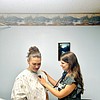Forest officials enjoy one of prescribed burning falls in years
HAYDEN BLACKFORD | Hagadone News Network | UPDATED 3 years AGO
After a tame fire season in 2022, Kootenai National Forest officials were able to burn more than 6,000 acres in prescribed burns this fall.
It's a drastic contrast to what has occurred in recent years when less than favorable conditions existed for mitigation efforts, officials said.
Cory Farmer has worked as a forest fuels planner since 2000, and it's a role he currently holds with the KNF. He began working on timber and fuels crews, and in a recent interview discussed the burn process and commented on the successful undertaking these past few months.
According to Farmer, pile burning is an active way the Forest Service mitigates fire danger. Excavator piles or other handmade piles of fuel that actively collected at a previous time are then burned under the right conditions.
Another method of prescribed burning targets active fuels and burning these natural fuels can be done through larger landscape burns.
The Forest Service also partners with the Montana Department of Natural Resources and Conservation for some burns and coordinates with county officials, Farmer said.
Some locations for prescribed burns are post harvest timber units. The Forest Service will burn in these areas so that excess fuels are managed effectively, but they also prepare sites for regeneration of trees. With rare exceptions Forest Service land is all the department will conduct prescribed burns on.
Active fuel burns can involve helicopter crews and large landscape burns, but also simple slash-and-go in smaller understory trees, according to Farmer. This cutting can ensure ladder fuels, or fuels that can carry the flames vertically up trees and surrounding structures, are trimmed.
This fall, the Kootenai Forest Service burned 2,600 acres of pile burns and 3,500 acres of natural fuels.
The Forest Service conducts burns in the spring, and lately a much higher percentage in the spring than the fall. Fall burning has been difficult the last seven years, according to Farmer.
“Mainly because fire seasons are extending through the fall,” Farmer said.
The Forest Service is hesitant to put more smoke into the atmosphere after summers of intense airborne particulate matter. This summer was a relatively quiet fire season all across the nation, Farmer said.
“It was one of the best falls we’ve had in a long time,” Farmer said.
To figure out where to burn, the Forest Service will go through the National Environmental Policy Act, and a number of specialists will come in to study proposed burn sites in order to make sure they are treating the right area, Farmer said.
Across Lincoln County’s forested area are a number of pests and diseases, such as bark beetles. Often, burning natural fuels is intended to reduce the total amount and improve wildlife habitat. Areas that have recently been burned can flourish, as native bushes and grasses establish themselves in a natural succession.
Natural fuel burns can also try to kill pockets of overstory trees. This can enable more sunlight to reach the ground, and reduces dense timber. Over Farmer’s career he noted that the required documentation to conduct a prescribed burn has increased.
All the necessary documentation had ensured a high percentage of success for burns over the years. Farmer noted there was a prescribed burn in New Mexico that escaped containment last year, but professional evaluations and years of planning are spent to ensure burns are as successful as possible, Farmer said. He noted that 99% of burns done by the Forest Service are successful.
Farmer lauded the professionals who have worked to make the work successful
"Eureka, Trout Creek, Troy, all these districts have great people," Farmer said. "Many out of the public eye, such as dispatchers, do a great job of helping manage the Kootenai Forest very well. They also do a great job of hitting the burn windows."
“Great place, great people, and just beautiful county,” Farmer said.
A backcountry burn situation may only need five to ten people plus a helicopter to be successful. The burns that are closer to private property may involve 20 to 30 people, and this doesn’t include dispatchers and others on stand by, Farmer said.
“There’s a ton of planning, and strong coordination with Idaho, as the states share an air shed,” Farmer said.
While prescribed burns can be positive for the natural environment they are used extensively to mitigate wildfire threats, Farmer said. Last year the Burnt Peak Fire, in the Three Rivers Ranger District southwest of Troy, burned through an area that had previously been treated by prescribed burns.
Fire closest to private homes had previously been a harvested and prescribed burn area, and the mitigation efforts gave firefighters tremendous opportunity to fight the fire without having to retreat or worry about containment, Farmer said.
"Treating the area effectively and significantly modified the fire's behavior to where we could keep ground crews on their main objective – which is often to keep fire on the ground from reaching the canopy," Farmer said.
If a fire reaches the canopy, or upper part of the trees, the movement can be erratic, it can release embers and intense heat.
“If there's a fully established crown fire there's nothing you can do,” Farmer said. “Then the fire is in charge.”
ARTICLES BY HAYDEN BLACKFORD

Flower Lake Road paving enhances access to recreation
Thanks to the perseverance of the Libby Outdoor Recreation Association, a section of Flower Lake Road is now paved.
The brouhaha over BORZ designations in Lincoln Co.
What are BORZ and what do these designations mean?

Young professional spends summer aiding Libby Clinic
The disparity between urban and rural healthcare is something that organizations are trying to bridge with exposure.

